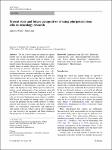Present state and future perspectives of using pluripotent stem cells in toxicology research
Wobus, Anna M.
Löser, Peter
The use of novel drugs and chemicals requires reliable data on their potential toxic effects on humans. Current test systems are mainly based on animals or in vitro–cultured animal-derived cells and do not or not sufficiently mirror the situation in humans. Therefore, in vitro models based on human pluripotent stem cells (hPSCs) have become an attractive alternative. The article summarizes the characteristics of pluripotent stem cells, including embryonic carcinoma and embryonic germ cells, and discusses the potential of pluripotent stem cells for safety pharmacology and toxicology. Special attention is directed to the potential application of embryonic stem cells (ESCs) and induced pluripotent stem cells (iPSCs) for the assessment of developmental toxicology as well as cardio- and hepatotoxicology. With respect to embryotoxicology, recent achievements of the embryonic stem cell test (EST) are described and current limitations as well as prospects of embryotoxicity studies using pluripotent stem cells are discussed. Furthermore, recent efforts to establish hPSC-based cell models for testing cardio- and hepatotoxicity are presented. In this context, methods for differentiation and selection of cardiac and hepatic cells from hPSCs are summarized, requirements and implications with respect to the use of these cells in safety pharmacology and toxicology are presented, and future challenges and perspectives of using hPSCs are discussed.
No license information

